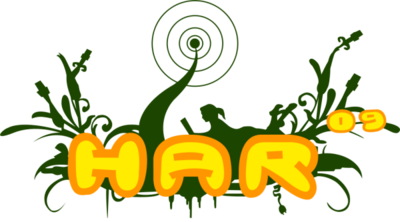HARMovieContest2009English
BlinkenArea Movie Contest
- Send your movies to contest 'at' blinkenarea.org
- Deadline: 16th August, 2009 at 11am
- Questions? Drop us a line!
blm - Blinkenlights Markup Language
The Blinkenlights Markup Language has been developed by Project Blinkenlights and has established as state of the art for flashing devices. The resolution for the TroiCade needs to be 32 x 24 pixel. Additionally, 128 scales of grey can be used. /wiki/Java_(software_platform) Java] and can be used on each operating system with Java runtime environment. On java.com you can get your version (Linux, MacOS X, Windows and Solaris). Blimp can be started as an application, but also online or offline in a web browser (Applet).
When using a graphic user interface, you can start the jar file by double click, usually. Of course, you can also do it on your console: java -jar Blimp.jar. Using the applet within a browser it starts automatically.
With Blimp, you can now create your own movies or animations and change respectively. Then, you can save it in the .bml file format. Blimp provides some simple painting functions. Furthermore, pictures and sequences can be integrated in standard formats, such as .png, .jpg oder .gif, but you can also prepare your 32 x 24 movie by a graphic programm (which might be not able to export bml files), import it into Blimp and finally save as .bml.
* Blimp Download file (incl. sources) * Download Blimp * Start Blimp in your browser
Scroller Perlscript
Pictures, which are oversized for the TroiCade, can be converted into a movie, which scrolls over the picture. When it is too high, it scrolls downwards. Pictures, that has a large width, it scrolls from left to the right. The speed can be chosen.
To use the script, you need Perl (z.B. ActivePerl - Perl Distribution for AIX, HP-UX, Linux, MacOS X, Solaris and Windows) and a programm, that can export pictures into the .pgm format (Portable Gray Map) (e.G. The GIMP - free graphic programm for Linux, BSD, Solaris, MacOS X and Windows).
The script can be started with the following syntax, when the picture is available in .pgm format (raw):
perl scroller.pl <pgm-image> <width> <height> <bml-output> [<interval>]
<pgm-image> = name of the source picture in .pgm format (raw)
<width> = width of the target animation (for TroiCade: 32)
<height> = hight of the target animation (bei TroiCade: 24)
<bml-output> = name of the target animation
[<interval>] = how long shall a frame of the target animation be displayed (in ms)
Example: perl scroller.pl testbild.pgm 32 24 testfilm.bml 120
* http://stefan.blinkenarea.org/scroller.pl
Converting movies in .bml format using MPlayer
To convert movies available as e.g. avi into .bml format, MPlaer can be used. Unfortunately, you need to acivate this functionality when using standard package from the various Liux distributions. You need to download the sources and compile MPlayer by yourself:
Download sources
If you would like to use "Binary Codec Packages" you need to download them as well and extract it to /usr/local/lib/codecs/.
Extract sources
tar -jxf MPlayer-x.xx.tar.bz2
change directory
cd MPlayer-x.xx
use configure with parameter --enable-bl to start the .bml support
./configure --enable-bl
compile
make
install
make install
The video, that you like to compile, should be available in resolution 32 x 24 or a multiple of it respectively, e.g. 320 x 240. Each resolution can be used, when aspect ratio is correct. Hence, you should choose a nice cutting of a movie to get the right aspect ratio. Furthermore, animations should be encoded with a jpeg codec, because only using this format, black appears as black in .bml format. Using different formats, such as mp4 or Raw, the first scale of gray will be saved as 1 instead of 0. When you finished your movie, it can be compiled.
mplayer -vo bl:grayscale:file=test.bml -zoom -vf scale=32:24 test.avi
